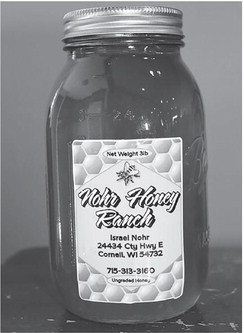“fed up” to make their ….


“fed up” to make their winter weight, with a liquid sugar soup. They’re then shipped to Florida for wintering, around mid-October. The Nohrs go back to Florida, in December, where the hives are treated and fed again.
They return again in January, to feed the bees, then send those who meet the grade to California to pollinate.
“It keeps us pretty busy,” said Israel. “We’ve gotten quite a bit bigger in the last 10 years, for sure. This is all I do.”
John says having an understanding wife and a good, dependable hired man have been integral for the ranch. According to John, there’s always been divine intervention, even during the rough times. John recalls what his friend always said: You know, beekeeping is just one crisis after another.
“Sometimes, it seems like that,” said John, “but it’s been a blessing to enjoy my occupation and to learn some life lessons from God’s creation. We’ve had many generous landowners willing to let us use a spot for a bee yard.”
Israel said people call the ranch if they need something pollinated, but that one or two hives on a plot of land is not feasible for the company. Only so many bees can sustain themselves within a certain area. Israel recommends only locating 72 hives within a couple miles of each other.
“We’re always looking for places to put bees on if people have something,” he said. “It’s nice to have options to put bees out.”
When the bees are shipped home from Florida, in the spring, the ranch starts with about 2,500 hives (700 on each semi).
“Then what happens, is we set these in there (dark room) for awhile and they’ll heat up overnight,” said Israel.
The “cap” is then cut off the frame and run through an extractor with rotating knives. The raw honey is piped to an old bulk milk tank the family purchased and filtered out for bottling.
“If you were to just do it on a small scale, you’d scratch the frames off by hand and it would take not very long,” said Israel. “We don’t retail any honey.”
Instead, the Nohrs have a local honey exchange program, along with a packer in Georgia, who buys most of the raw honey. Whatever honey is left from pollinating in Wisconsin, is brought home at the end of July, so they can start extracting honey that was collected during that time frame. Israel says their home bottling system is not set up for mass producing or processing.
“In the past, we’ve done once a year, but now we do it twice, because we bring them back from Florida,” he said.
If the family ever decided to bottle their own honey, they would need a partially automated system to handle the volume. They also don’t sell their beeswax that is collected from floating on top in the bulk tank, but they do have some in storage.
“There’s a pretty good market for it, but we don’t produce a ton,” said Israel. “It’s 1,000 pounds a year, maybe.”
When working with the bees, sometimes the keepers wear suits and sometimes not when maintaining the hives. Solar fences are situated around the hives, to help protect them from animals.
“The ones that don’t pollinate, those we put in yards and make sure they have enough boxes on them (to maintain the population),” said Israel. “Each hive has one queen. That’s kind of the standard procedure. Then, if they get too crowded throughout the summer – if you don’t get around to them fast enough or…the older the queens are, the easier they swarm. We lose some that way.”
Weather definitely plays a factor; if it is hot and humid, the bees don’t need as many bodies in the hive to keep it warm.
As they continue to grow each year, Israel and John now have a third generation beekeeper to learn the ropes, with Israel’s 10-year-old son, Logan, by their side.
“He’s pretty good help,” said Israel.
With the full-time work, Israel says it is interesting and keeps the ranch busy as the Nohrs see the years pass by. John agrees, and is grateful that he’s been able to support his family.
“You couldn’t ask for a more interesting occupation,” said John.
A cutter takes the cap off frames, to get at the raw honey inside.
SUBMITTED

